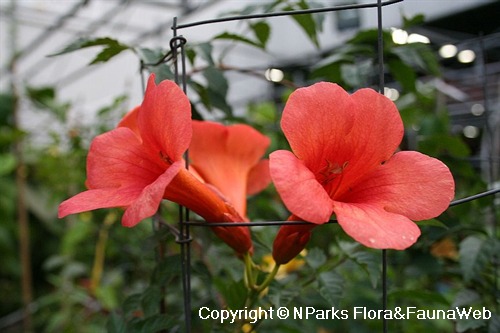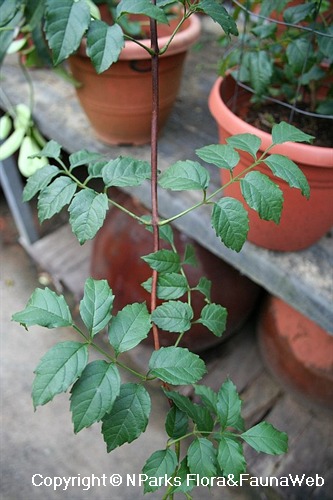
Back
Campsis radicans (L.) Seem.
| Family Name: | Bignoniaceae |
| Synonyms: | Tecoma radicans |
| Common Name: | Trumpet Honeysuckle, Trumpet Vine |
Name
Classifications and Characteristics
| Plant Growth Form | Climber |
|---|
Biogeography
| Native Distribution | North America |
|---|---|
| Native Habitat | Terrestrial |
| Local Conservation Status | Non-native |
Description and Ethnobotany
| Growth Form | A fast-growing woody climber, it climbs by means of its aerial roots and can grow up to 10m. |
|---|---|
| Foliage | The leaves are pinnately compound with odd-numbered, serrated leaflets and are arranged in opposite pairs along the stem. |
| Flowers | The bisexual, red flowers are borne in clusters of 4 to 12. The calyx is campanulate in shape with triangular lobes. The flower corolla can grow up to 7cm in length and is tubular-funnelform in shape. |
| Cultivation | It is best grown in moist, well-drained soil. |
Landscaping Features
| Desirable Plant Features | Ornamental Flowers |
|---|---|
| Landscape Uses | Parks & Gardens, Trellis / Arbour / Pergola |
Plant Care and Propagation
| Light Preference | Semi-Shade |
|---|---|
| Water Preference | Moderate Water |
| Plant Growth Rate | Fast |
| Rootzone Tolerance | Moist Soils, Well-Drained Soils |
| Propagation Method | Seed, Stem Cutting (Hardwood) |
Foliar
| Foliage Retention | Deciduous |
|---|---|
| Mature Foliage Colour(s) | Green |
| Mature Foliage Texture(s) | Glossy / Shiny |
| Foliar Type | Compound (Odd-Pinnate) |
| Foliar Attachment to Stem | Petiolate |
| Foliar Margin | Serrate / Toothed |
Floral (Angiosperm)
| Flower & Plant Sexuality | Bisexual Flowers |
| Flower Colour(s) | Orange, Red |
|---|---|
| Flower Grouping | Cluster / Inflorescence |
| Flower Location | Terminal |
| Inflorescence Type | Cyme |
Image Repository
Others
| Master ID | 64 |
|---|---|
| Species ID | 1360 |
| Flora Disclaimer | The information in this website has been compiled from reliable sources, such as reference works on medicinal plants. It is not a substitute for medical advice or treatment and NParks does not purport to provide any medical advice. Readers should always consult his/her physician before using or consuming a plant for medicinal purposes. |

